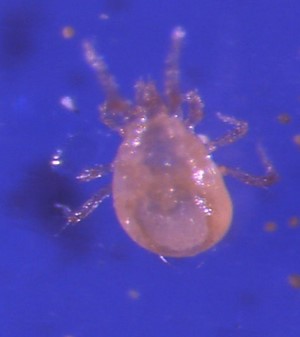By Sriyanka Lahiri
Currently, strawberry production in Florida is particularly susceptible to infestation by chilli thrips (Scirtothrips dorsalis). Although chilli thrips had been reported as a pest of ornamentals in Florida before, it wasn’t until 2015 when strawberry fields started to be severely impacted by this invasive pest.

CHEMICAL CONTROLS
Chemical control is the predominant tool to manage chilli thrips. However, pesticide resistance development in thrips has been a major concern.
Chilli thrips collected early in the strawberry season (November) show 30% higher mortality when treated with various insecticides compared to those populations collected later in the season (January–February). The mortality in chilli thrips collected later in the season can be as low as ~50% when insecticides such as spinetoram (Radiant), cyantraniliprole (Exirel) and acetamiprid (Assail) are applied. Flupyradifurone (Sivanto Prime) also provides effective adult chilli thrips suppression, but thrips management later in the season becomes difficult in a strawberry crop spanning five to six months.
The above insecticides should only be applied twice per season and rotated with another mode of action before applying a second time. Combining these insecticides with an insect growth regulator provides improved suppression of immature thrips.

BIOLOGICAL CONTROLS
These insecticides are effective in suppressing adult chilli thrips populations, but biological control is an effective tool to suppress the larval (immature) stages that remain hidden and protected under fruit calyxes. The biological control agents include predatory mites (Amblyseius swirskii and Neoseiulus cucumeris).
These species of predatory mites not only feed on thrips adults and immatures, but also on other strawberry pests such as two-spotted spider mite(Tetranychus urticae) and cyclamen mite (Phytonemus pallidus) eggs, immatures and adults. Since mite pests are also resistant to most miticides, these biological control agents provide a very dependable alternative. Therefore, multiple soft-bodied insect and mite pests can be managed in strawberry by releasing these commercially available predators.
Additionally, for thrips management, entomopathogenic nematodes (EPNs) are effective biological control agents. The EPNs Steinernema feltiae and Heterorhabditis bacteriophora show efficacy when used as a foliar application twice within a period of five to seven days, while avoiding a spray equipment pressure of more than 300 psi. Both EPNs and predatory mites will perform better and avoid dehydration when applied to a strawberry crop around sunset rather than at noon.
Lastly, for thrips control, biorational pesticides that are based on entomopathogenic fungi and plant extracts are also effective when applied at least twice within a five- to seven-day period. These commercially available pesticides include Beauveria bassiana (Mycotrol ESO; entomopathogenic fungi), neem extract (Azera; azadirachtin + pyrethrin) and capsicum oleoresin extract (Captiva Prime).

EARLY IPM NEEDED
Early-season suppression of thrips, especially chilli thrips, is of utmost importance so that thrips cannot establish on the crop in high numbers. Since chilli thrips feed on young foliage, in addition to flowers and fruits, the onset of their infestation begins almost immediately as the strawberry transplants are planted.
As the invasive range of this thrips pest expands outside of Florida, diligent use of these integrated pest management (IPM) tactics can prevent resistant chilli thrips from spreading to other strawberry-growing states within the United States.
Sriyanka Lahiri is an assistant professor at the University of Florida Institute of Food and Agricultural Sciences Gulf Coast Research and Education Center in Wimauma.










